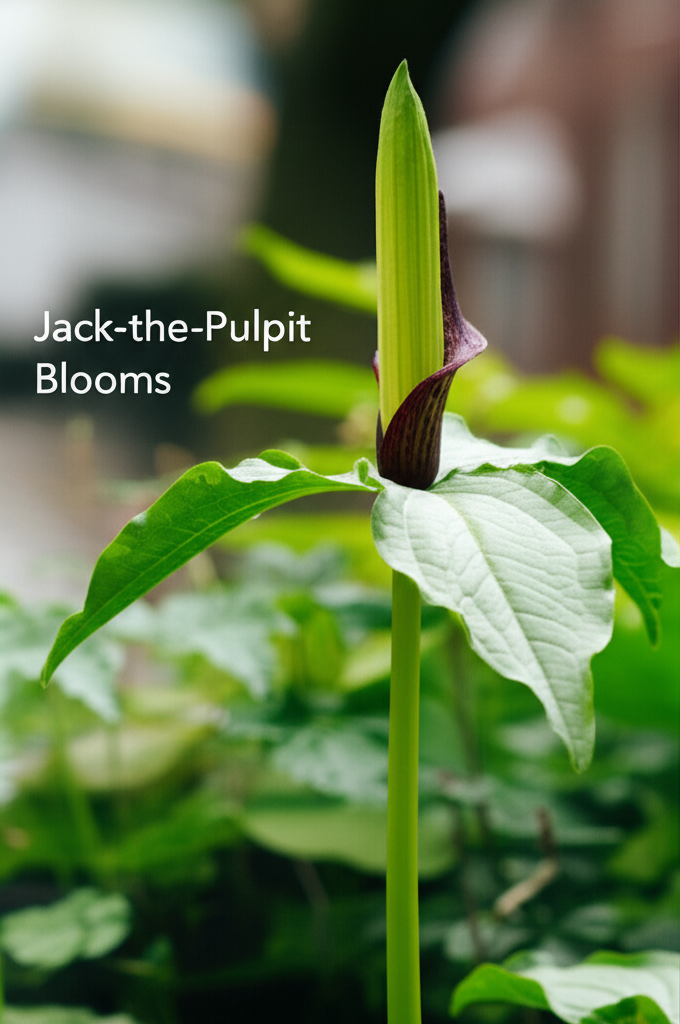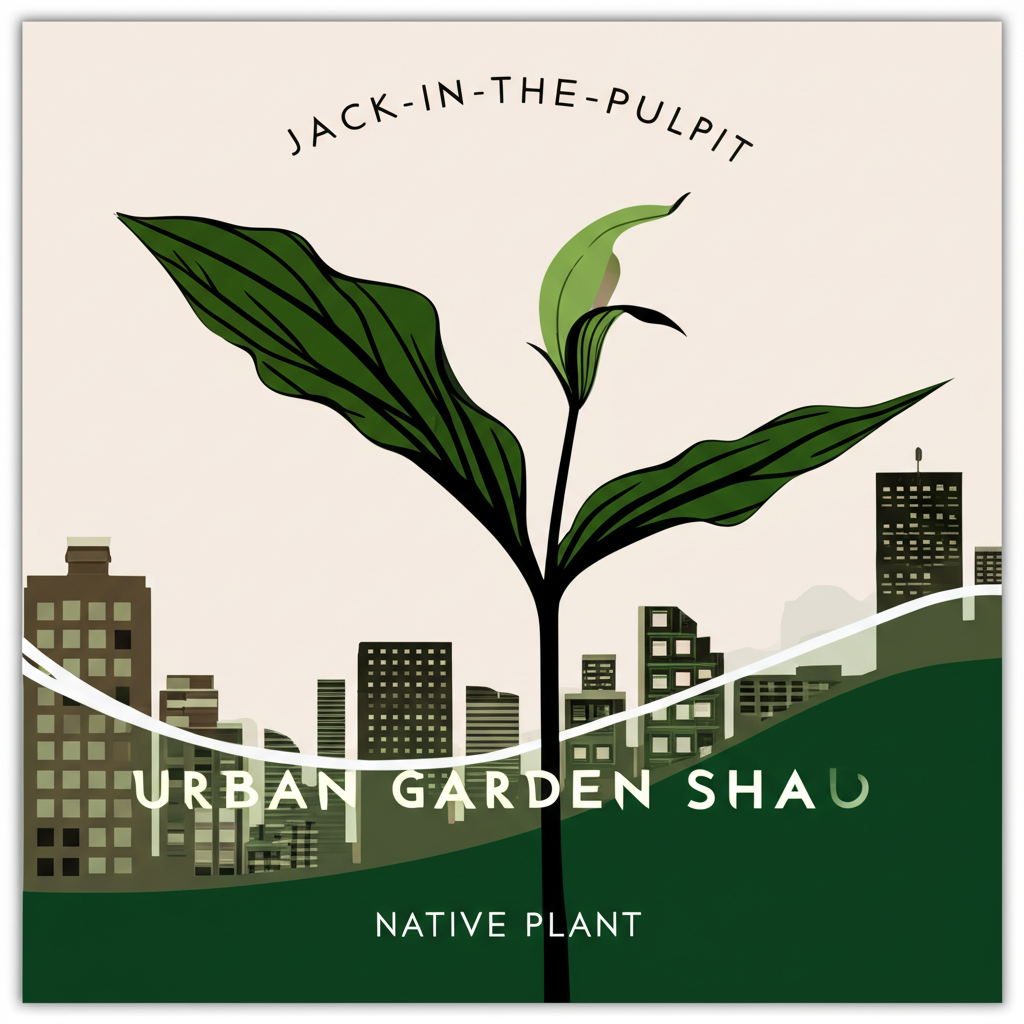Introduction: Bringing a Woodland Wonder to Your City Oasis
Urban gardening is blossoming into a vibrant movement, with city dwellers increasingly seeking to reconnect with nature and support local ecosystems. Amidst the concrete and steel, native plants offer a powerful solution, providing essential resources for wildlife and adding a touch of wild beauty to even the smallest spaces. Among these remarkable natives, the Jack-in-the-Pulpit (Arisaema triphyllum) stands out as a particularly intriguing and valuable addition to any urban wildlife garden.
Often found in the dappled shade of woodland floors, this unique herbaceous perennial boasts a fascinating flower structure that resembles a preacher in a pulpit, hence its common name. Beyond its captivating appearance, the Jack-in-the-Pulpit is a champion of biodiversity, offering sustenance and shelter to a surprising array of urban wildlife. This article delves into why this woodland native is an ideal choice for city gardeners, exploring its ecological benefits, cultivation needs, and how to best integrate it into your own urban sanctuary.
Understanding the Jack-in-the-Pulpit: A Botanical Marvel

The Jack-in-the-Pulpit, also known as Indian Turnip or Bog Onion, is a member of the Araceae family, which includes other well-known plants like Calla Lilies and Peace Lilies. Its scientific name, Arisaema triphyllum, refers to its characteristic three-parted leaf (triphyllum) and the prominent spathe that encloses the spadix (Arisaema).
Key Features and Identification
- The “Pulpit”: The most distinctive feature is the spathe, a hooded, leaf-like structure that curves over the spadix. The spathe’s color can vary, often exhibiting green, purple, or brown hues, sometimes with intricate stripes.
- The “Jack”: The spadix is a fleshy, finger-like spike that emerges from the center of the spathe, often tipped with a club-like appendage. This is where the actual tiny flowers are located.
- Leaves: Typically, a mature plant will have two large, compound leaves, each divided into three ovate leaflets. The leaves emerge on sturdy stalks from the corm.
- Growth Habit: It is a herbaceous perennial that grows from a corm, a bulb-like underground structure. It emerges in spring, flowers, produces a cluster of bright red berries in late summer or fall, and then dies back to the ground in winter.
- Size: Mature plants generally reach heights of 1 to 3 feet (30 to 90 cm).
Life Cycle and Reproduction
The Jack-in-the-Pulpit has a fascinating reproductive strategy. The plant is dioecious, meaning individual plants are either male or female, although some can be monoecious (having both male and female flowers on the same plant) or even change sex over time. Pollination is primarily carried out by small insects, such as gnats and flies, which are attracted to the spadix. After pollination, the female plant will produce a cluster of vibrant red berries, which are a crucial food source for birds and other wildlife. These berries are mildly toxic to humans, hence the “Indian Turnip” name, as Native Americans developed methods to detoxify and eat the corms after extensive preparation.
Ecological Significance in Urban Environments
In the context of urban wildlife gardens, the Jack-in-the-Pulpit offers a wealth of benefits, acting as a vital keystone species in a miniature ecosystem. Its presence can significantly contribute to the ecological health of your garden and the surrounding urban landscape.
Providing Food Sources
- Berries for Birds: The bright red berries produced in the fall are a crucial late-season food source for various bird species, including robins, thrushes, and finches. This is especially important in urban areas where natural food sources can be scarce.
- Insect Attraction: The unique flower structure, while not producing nectar, can attract small insects, which in turn can serve as a food source for insectivorous birds and other beneficial predators within the garden.
- Pollinator Support: While not a primary nectar producer, the plant still supports a variety of small pollinators, contributing to the overall biodiversity of your garden.
Offering Shelter and Habitat
- Cover for Small Creatures: The broad leaves and sturdy stalks provide excellent cover and hiding places for small ground-dwelling animals, such as amphibians (frogs, toads) and beneficial insects.
- Moisture Retention: In its natural habitat, the Jack-in-the-Pulpit thrives in moist environments. Its presence can help indicate and even contribute to maintaining soil moisture, which is beneficial for a range of microfauna.
Supporting Native Plant Communities
By incorporating the Jack-in-the-Pulpit, you are supporting a native plant that has co-evolved with local wildlife. This encourages a more robust and resilient ecosystem compared to relying solely on non-native ornamental plants.
Cultivating Jack-in-the-Pulpit in Your Urban Garden
Despite its woodland origins, the Jack-in-the-Pulpit can be successfully cultivated in urban settings with the right conditions. Understanding its preferred habitat is key to its thriving.
Ideal Growing Conditions
- Light: This plant thrives in partial to full shade. Direct, harsh sunlight can scorch its leaves. Aim for locations that receive dappled sunlight throughout the day or are consistently shaded.
- Soil: Jack-in-the-Pulpit prefers rich, moist, well-drained soil. It does well in loamy or humus-rich conditions. Avoid waterlogged areas, but ensure the soil retains moisture. Adding compost or other organic matter will greatly benefit its growth.
- Water: Consistent moisture is essential, especially during the growing season. Water regularly, particularly during dry spells, but allow the soil surface to dry slightly between waterings.
- Temperature: It is a hardy perennial that can withstand a wide range of temperatures once established.
Planting and Care
- Propagation: Jack-in-the-Pulpit is typically grown from seed or division of corms. Seeds can take several years to reach maturity. Corm division is a faster method; carefully divide mature corms in early spring or fall.
- Planting Depth: Plant corms with the pointed end facing upwards, about 2-4 inches deep, depending on the size of the corm.
- Spacing: Space plants 12-18 inches apart to allow for adequate growth and air circulation.
- Mulching: Apply a layer of organic mulch around the base of the plant to help retain soil moisture, suppress weeds, and regulate soil temperature.
- Pest and Disease: Jack-in-the-Pulpit is generally pest and disease resistant. Overwatering or poor drainage can lead to root rot, so ensure good drainage is a priority.
- Dormancy: Allow the foliage to die back naturally in the fall. This allows the plant to store energy in the corm for the following year. Do not cut the leaves until they have yellowed and withered.
Integrating Jack-in-the-Pulpit into Urban Wildlife Garden Designs
The unique aesthetic and ecological value of the Jack-in-the-Pulpit make it a versatile addition to various urban garden designs. Consider these ideas for incorporating it effectively:
Shady Nooks and Woodland Corners
The most natural setting for Jack-in-the-Pulpit is in shady areas. Plant it under trees, in the north-facing corner of a building, or within existing shrubbery. It pairs beautifully with other shade-loving native plants such as ferns, hostas (though not native, they tolerate shade well), native asters, and woodland phlox.
Container Gardening for Small Spaces
Even the smallest urban balcony or patio can host a Jack-in-the-Pulpit. Plant it in a large pot filled with good quality potting mix, ensuring adequate drainage. Place the pot in a shaded location and maintain consistent watering.
Creating a Biodiverse Microhabitat
Combine Jack-in-the-Pulpit with other native plants that offer different resources and bloom times to create a dynamic wildlife haven. Consider including plants that provide nectar for pollinators earlier in the season, berries for late-season foragers, and seed heads for winter bird food.
Educational Opportunities
The unusual appearance of the Jack-in-the-Pulpit makes it an excellent subject for educational purposes, especially for children. Its life cycle and its role in supporting wildlife can spark curiosity and a deeper appreciation for nature.
Comparison with Other Urban Wildlife Garden Plants
To further appreciate the value of the Jack-in-the-Pulpit, let’s compare its attributes with other popular native plants for urban wildlife gardens:
| Feature | Jack-in-the-Pulpit (Arisaema triphyllum) | Coneflower (Echinacea purpurea) | Milkweed (Asclepias tuberosa) | Wild Geranium (Geranium maculatum) |
|---|---|---|---|---|
| Sun Exposure | Partial to Full Shade | Full Sun | Full Sun | Partial to Full Shade |
| Soil Preference | Moist, Rich, Well-Drained | Well-Drained | Well-Drained | Moist, Well-Drained |
| Primary Wildlife Benefit | Berries for birds, shelter for small creatures | Nectar for pollinators, seeds for birds | Nectar for Monarchs, food for other pollinators | Nectar for pollinators, seeds/foliage for insects |
| Bloom Time | Late Spring | Summer | Summer | Spring |
| Unique Feature | Distinctive “pulpit” flower, mild toxicity of corm | Drought tolerance, long bloom period | Essential for Monarch butterflies | Attractive foliage, long bloom period |
Pros and Cons of Planting Jack-in-the-Pulpit in Urban Gardens
Every plant has its strengths and weaknesses, and the Jack-in-the-Pulpit is no exception. Understanding these can help you make an informed decision for your garden.
| Pros | Cons |
|---|---|
| Unique and captivating aesthetic: Its unusual flower structure adds a focal point to any garden. | Specific light requirements: Primarily thrives in shade, limiting its placement in very sunny urban gardens. |
| Excellent for shade gardens: Fills a niche often difficult to plant in urban settings with limited sun. | Mild toxicity: The corm is toxic if ingested raw by humans or pets, requiring caution. |
| Provides important food source: Berries are valuable for late-season bird feeding. | Slow to establish from seed: Can take several years for seedlings to mature and bloom. Division is faster but requires established plants. |
| Supports beneficial insects: Attracts small insects that can aid in garden pest control. | Can be sensitive to overwatering: Requires good drainage to prevent root rot. |
| Low maintenance once established: Requires minimal care beyond initial planting and consistent moisture. | Not a showy bloomer: The flowers are subtle and hidden within the spathe, not meant for vibrant floral displays. |
| Native plant benefits: Contributes to local biodiversity and supports native wildlife. | May require companion planting for best effect: To maximize wildlife appeal throughout the season. |
Conclusion: A Small Plant with a Big Impact
The Jack-in-the-Pulpit is more than just a curious botanical specimen; it is a testament to the power of native plants to transform urban landscapes into thriving havens for wildlife. Its unique beauty, coupled with its valuable contributions to the ecosystem—from providing essential food sources to offering shelter—makes it an indispensable addition to any urban wildlife garden. By embracing the Jack-in-the-Pulpit, city gardeners can cultivate a deeper connection with nature, support local biodiversity, and create a more beautiful, resilient, and ecologically vibrant environment, one shady corner at a time.


